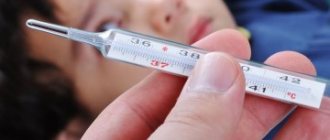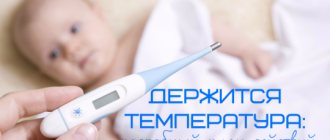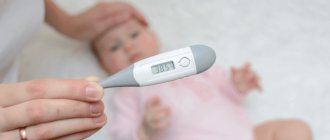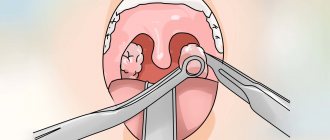The most important thing about a temperature of 38 in a 3-year-old child
There are a small number of facts that you should know about this temperature in order to correctly assess the situation and make decisions when dealing with an organism that is still very delicate and not adapted to the surrounding world. These are the facts:
- a temperature of 38℃ in a 3-year-old child does not mean that he/she has an infection,
- but most likely it is caused by a virus,
- You may not know the cause of the fever until other symptoms appear, and other symptoms may take 1 to 3 days to appear.
- 38℃ is a low (low-grade) temperature, and this is good for sick children because it helps the body fight infection.
What could be the reasons?
Almost all gradations of hyperthermia are caused by an infection - viral or bacterial. And if a temperature of 38 in a three-year-old child occurs without any symptoms at all, then the cause is most likely a bacterial disease, but this does not negate the mandatory diagnosis. However, viruses cause 10 times more infections than bacteria.
Cold or flu
Colds, flu and other acute respiratory viral infections and acute respiratory infections are the most common cause of hyperthermia at a young age. A child's temperature may be the only symptom during the first 24 hours. The typical onset of viral symptoms—a runny nose, cough, and sore or red throat—can sometimes linger, although this does not happen often.
Bacterial infections
Bladder infections are the most common cause of a temperature of 38 in a 3-year-old child with no other symptoms. But most often such infections occur in girls.
Streptococci
They can cause a small number of diseases with similar names. Usually, with a streptococcal infection, the child’s throat is the first to suffer. Rarely, they are also a common cause of unexplained fever.
Meningitis
If the temperature is caused by meningitis, then this is already very serious. The main symptoms are neck stiffness, headache and confusion. Children as young as 3 years old are often lethargic or so irritable that they cannot be comforted.
Meningitis is insidious in that it can occur in children with a very different set of symptoms and signs without any pattern. However, very rarely this disease occurs without other symptoms - most often there is a headache and neck stiffness, and the child’s temperature itself rises above 39 degrees.
If meningitis is not treated in the early stages, the child can suffer severe brain damage, including death.
Overheat
When overheating, the temperature of a 3-year-old child directly depends on the degree of overheating, but usually it is low - the one we are considering, 38℃. By overheating here we also mean sunstroke.
The temperature returns to normal within a few hours after moving to a cooler place. May also occur during strenuous exercise. Hyperthermia goes away quickly with rest and drinking plenty of fluids.
Roseola
This is the classic cause of unexplained fever in young children. Most children develop roseola between the ages of 6 months and 3 years. The cause of the disease is the human herpes virus.
Most often, roseola, in addition to a temperature of 38, is accompanied by other symptoms:
- rash is the main sign of the disease: at first, small pink spots usually appear on the chest and abdomen; then the rash spreads equally on both sides of the body and then to the face and other parts of the body;
- classic feature in a child at 3 years old: 1, 2, 3, 4, but usually no more than 5 days of high fever without rash or other symptoms,
- the rash most often begins 12-24 hours after the temperature drops,
- the rash itself lasts from 1 to 3 days,
- When the rash appears, the child will already feel well.
Temperature in a 7 month old baby Komarovsky
Doctor Komarovsky. Temperature and nothing else.
Dr. Komarovsky will explain the situation and explain to us what to do if the child has a fever and no other symptoms.
An elevated temperature in a child always indicates a health problem and the occurrence of some inflammatory process in the body. In children, the temperature most often rises due to infectious and inflammatory processes - this is how the immune system reacts to pathogens, trying to cope with them. In this case, as a rule, the temperature is accompanied by other symptoms characteristic of a particular disease: runny nose, sneezing or coughing, diarrhea or vomiting, rash.
But sometimes the temperature rises for no reason, it can last for several days and not subside. And besides temperature, there may not be any symptoms. Moreover, such a temperature may not bother the child at all and may not affect his behavior in any way. There may be several reasons for such an incomprehensible temperature, and in order to understand what to do in this case, you need to find out.
Both in the first months of life and in adulthood, a child’s temperature without other symptoms may rise due to overheating. In infancy, this is due to the fact that the process of thermoregulation in a small body is not yet sufficiently adjusted. The risk of fever is especially high in infants who are breastfed and whose mothers refuse to give additional fluid. If the baby is also heavily wrapped up, fluid leaves the body intensively, and milk alone is not enough to replenish the losses.
In older children, the temperature without symptoms may rise as a result of overheating if the baby is in a hot and stuffy room for a long time or in the summer - in the open sun.
Temperature without symptoms in a child for neuralgic reasons is also associated with disturbances in the thermoregulatory process. In addition, the temperature can also rise in children who are too emotional, with an overly excitable nervous system.
Sometimes even seemingly insignificant factors, such as bright and harsh light or loud sound, can provoke a rise in temperature.
Everyone is accustomed to the fact that a condition such as an allergy always manifests itself with some external symptoms - a runny nose, a rash, watery eyes. It turns out that this is not always the case: sometimes an allergy manifests itself only by an increase in temperature without any other signs. A fever due to an allergy usually indicates the presence of a serious allergic reaction, so it is necessary to act immediately in this case.
Fever without symptoms can also appear in children with such a complex and serious illness as heart disease. This disease is often accompanied by sudden changes in temperature, which is extremely undesirable for a small heart. And, as a rule, this situation arises most often in connection with climate change, which is why doctors advise children with heart defects to be hardened from an early age.
This group of disorders also includes joint diseases: arthritis, rheumatism - one of the characteristic manifestations of these diseases is an increase in body temperature, even if other signs are not observed. And if you notice “unreasonable” low-grade fever (increase in body temperature to 36.9-37.2 ° C) in the off-season, and the child also complains of pain in the legs, then the likelihood of such a disorder increases.
The inflammatory process that develops in a child’s body due to infection can also begin with fever without any other symptoms. The baby’s body reacts to microorganisms with heat, trying to “burn” them. In principle, inflammatory processes are characterized by other specific signs, but it also happens that the process occurs hidden, only accompanied by increased temperature. Often, it is with temperature that “childhood” infectious diseases begin, such as measles, chickenpox - watch your child.
There is also such a thing as pyrogenic reactions - an increase in temperature without other symptoms due to the artificial entry of foreign substances into the body. A striking example of this: a child with fever without symptoms after a routine vaccination. While some children tolerate the vaccine absolutely painlessly, some may have a fever for several days after vaccination.
Also, pyrogenic reactions may be associated with the use of low-quality medications. And this once again suggests that before taking any medications you should always read the instructions and pay attention to the expiration date.
What to do if you have a fever without other symptoms
If you have identified the cause of a fever without symptoms, you know what to do.
If you are overheated or dehydrated, you should dress your child a little lighter. Make sure that in the summer he is not exposed to the open sun and do not even let the child into the shade without a hat - protection from ultraviolet radiation is always necessary. The child should drink enough liquid, and always plain clean water.
If there is a “nervous” factor, then it is necessary to eliminate its influence. If the temperature arose as a result of an already experienced circumstance, that is, due to a single stress (for example, taking blood for a test or forced separation from the mother), you need to try to calm the baby, divert his attention, and compensate for the breakdown with increased care and affection. Try to avoid repeating the situation that worries your child in the future, and if this is not possible, then learn to prepare him in advance for what is coming.
If an allergic reaction occurs, it is very important to find the source of the allergy as quickly as possible and isolate it from the child. A blood test will help confirm suspicions. Usually, against the background of allergic processes, the level of eosinophils in the blood is increased.
The temperature has risen after the vaccination, the doctors are reassuring, there is no reason to worry - this is a common reaction.
If the cause is not known, it will need to be determined. Watch your baby: perhaps in a day or two other symptoms will appear that will indicate an incipient illness.
Analyze all recent actions: what the child ate, what medications he took, where he was - perhaps you will find a reason. If you can’t cope on your own, you will have to seek help from a pediatrician.
Most likely, he will send you for examination to determine the cause of the temperature.
Let your children, if they get sick, get sick easily and recover quickly!
Health to you and your children!
Doctor Komarovsky. Temperature and nothing else.
Komarovsky about temperature.
the content of the article
Cough, runny nose, sore throat, fever. The situation is unpleasant, but understandable. And if all this is missing, and the temperature has risen. High temperature and nothing else.
Situation: you touched your forehead, it seemed hot, but there was nothing else. Scary and incomprehensible. If you have a fever and you don’t understand why the fever is high, it won’t hurt to contact a person who should understand it better than you. In situations of high fever, you often have to consult a doctor.
High temperature and overheating of the child.
This morning, the mother suddenly discovered that the child had a high temperature. Why did you start measuring temperature? Because my forehead was hot to the touch. You took his temperature, his temperature was 38. You took him to the doctor. And the doctor declares: the lungs are clean, the throat is not red, the nose is dry, I don’t see the cause of the temperature. Every mother finds herself in this situation, sooner or later. You cannot raise a child without this situation arising: there is a high temperature, but there is nothing else. What to do? What will you do? See how long it will last. The mother suspects that the child is overheated. Although 38 is a bit high for overheating. As a doctor, I will say that 38 for overheating is normal, and for our country it is more than normal. Then we gradually begin to list lists of those diseases that cause high fever without any symptoms. Indeed, one of these conditions is overheating, which often occurs in the summer. And the younger the child, the more relevant this topic is.
What causes high temperature?
In the vast majority of cases, the cause of high fever without symptoms in summer is overheating, and the rest of the time - viral infections. What are the rules for treating a viral infection? Moistening the nasopharynx, humidifying the room, ventilating. These are the rules for the treatment of viral respiratory infections. The main rule of treatment is to create conditions where the child can cope with the infection on his own.
When to see a doctor if you have a high temperature?
Of course, if we are not in the country, we are in the city, then we will immediately go for help. Doctors' calls not to self-medicate and to consult a doctor when the temperature rises are absolutely fair, because a dangerous disease with specific symptoms can begin with a slight increase in temperature. But in 50% of cases, when the child’s temperature rises, mothers do not go to the doctor. They always wait a few days. Therefore, we will now try to formulate rules for when there is no point in waiting, when you definitely need to see a doctor.
- No improvement on day 3 of illness.
- Lack of normalization of temperature on day 5.
What do you mean not better? When it was 39, and on the third day it was 38, then this is an improvement. And if it was 38, and on the third day it was 38.2, then you urgently need to see a doctor.
And on day 5 the temperature should be normal.
If the mother does not see symptoms when the temperature rises, this does not mean that they do not exist. There are symptoms that a mother cannot see in principle; only a person with a medical education can see them.
Therefore, an incomprehensible situation is a reason to contact a doctor.
Temperature and nothing else.
Temperature 37.5, cough and snot - definitely a viral infection. But the temperature and nothing else is a viral infection, but what kind is not clear. If you have the opportunity to see a doctor, do so. And what will happen next? Most likely, if the mother did not see the symptoms, the doctor will not see either. And when a doctor says the phrase “I don’t see anything,” then in the eyes of our average person he seems like the wrong doctor, a bad one. Well, what kind of doctor is this, who has been trained for so many years and cannot make a diagnosis when there is a fever, and he honestly admitted it. Therefore, the mother will go with the child to another doctor, who will say: “Oh, your throat is a little red.” But I must admit that in 30 years of treating children, I have not seen a neck that is a little red, a little blue, a little green, or a little purple. All the necks are a little red. Advice for mothers: occasionally look into the mouth of your healthy child so that you understand what kind of throat your child should have normally. And when the doctor says a little red, you will say the same as always. And it will be easier for the doctor.
How to bring down the temperature.
At what temperature do you need to take some measures? Measures need to be taken when your child is really unwell. If the room is hot, the room is dry, the child does not drink, the child is not healthy, then we need to help the child fight the increase in body temperature. Another question is that for our mother to fight a rise in temperature is to run to the pharmacy and give the child a sweet syrup. And to fight a high temperature means ventilate, humidify, give water and do everything to ensure that there is cool air in the room.
Causes of high temperature.
The causes of high temperature are infectious and non-infectious. The most common non-infectious cause is overheating. It is in our country, when a child is wrapped in 5 clothes, and in winter in 10, that overheating is the main reason for a rise in temperature without symptoms. Therefore, think about the temperature in the room, how many diapers the child is wearing, whether you were running in the heat. However, very often a fever is just an infection. Infections can be viral or bacterial. Viral infections go away on their own, but bacterial infections can be treated with antibiotics. Moreover, bacterial infections are accompanied by specific symptoms. If a child has otitis media, then the ear hurts, and if a child has a sore throat, then his throat hurts. And if there is fever and diarrhea, then this is an intestinal infection. And if there is an elevated temperature and a characteristic rash, this is chickenpox. There is one bacterial infection that is not accompanied by any symptoms in children. This is a urinary tract infection. Those. If the child simply has a fever and there are no other symptoms, then a clinical urine test is very necessary.
How can a mother distinguish a viral infection from a bacterial one?
With viral infections, the child’s skin is bright, pink, and with bacterial infections, it is pale. If 39 and the ears are red, you don’t have to fuss, but if 37 and the child is lethargic and pale, then a doctor is urgently needed.
Temperature and nothing else are, as a rule, not dangerous. But do not neglect seeking medical help; together with a doctor you will be much stronger.
How to reduce a child's temperature
A high mark on the thermometer indicates that the child’s immunity has begun to fight the infection.
Elevated temperature (hyperthermia, fever) is the body’s protective reaction to the invasion of external destructive microorganisms. Thus, microbes, once in the baby’s internal environment, begin to actively multiply and release toxins. In response to the implantation, the brain, in particular the thermoregulation center, gives instructions to change the temperature level to activate leukocytes and increase the production of antibodies.
Doctor Komarovsky - How to bring down the temperature
Every mother knows how her baby behaves at elevated temperatures. Some people immediately blush and want to lie down, while others run around the house until the very end and don’t even want to sit down for a minute. But what to do if the thermometer scale is alarmingly high? How to reduce a child's temperature? And in general, what temperature should a child be brought down? Today we will find out the answer to these questions...
How to reduce a child's temperature at home
First, you should understand that there are two types of hyperthermia: “pale” and “red.” The most common is “red”, which is characterized by redness of the skin, wet extremities, rapid breathing and no changes in the baby’s behavior. In this case, only physical methods (wraps, rubdowns) can be used to reduce the temperature.
Pale fever is more dangerous. It is dangerous due to a sharp increase in temperature and its frequent fluctuations. It is signaled by pale skin, bluish tint of lips, cold extremities and changes in the baby’s behavior. Quite often, it is precisely such circumstances that require calling an ambulance.
If the baby has a severe fever, the first thing parents are interested in is how to quickly bring down the child’s temperature. So, the first measures are related to ensuring heat loss by the body. These include:
- drinking plenty of warm liquid, even if you don't feel like it
- coolness in the room (no more than 21 degrees)
- bed rest
- open arms and legs of the patient.
If you are interested in how to bring down the temperature of a one-year-old child, then pay attention to raisin decoction. A little older children can be given dried fruit compote.This is just the beginning of the list of “grandmother’s” advice. Wraps, the use of enemas, compresses - these are the valuable methods of self-help that we have inherited.
When you need to bring down a child's temperature to 39, a very effective method comes to the rescue - a cool bath. For this, the baby is dipped to the waist in slightly warm water. This bath can last up to 20 minutes and is repeated 2 times.
The effectiveness of some antipyretics should not be overlooked. This list includes paracetamol, acetylsalicylic acid, ibuprofen. You can also bring down the child's temperature with analgin. And although the drug has a bad reputation in the United States and Europe, in an emergency it helps like no other. And from a single dose there will be more benefit than harm.
How to lower a child's fever with vinegar?
Rubbing with vinegar takes first place in the treasure trove of folk recipes. To do this, mix vinegar with water in a ratio of 1:5. The resulting liquid should taste just a little sour. Next, you need to moisten a cloth or sponge and wipe the baby’s skin: first the tummy and back, then the legs, arms, feet and palms. The procedure is repeated every 2-3 hours.
When wiping with vinegar, you need to take into account several important safety rules. Firstly, only warm water is used for consistency, since cold liquid will not only cause discomfort, but can also lead to cramps. Secondly, it is forbidden to rub the vinegar solution into the body - the baby’s skin is still very delicate, thin and has large pores. Moreover, until recently, the baby fed through the skin while in the womb. Therefore, the absorption of vinegar through the skin may not only not reduce the fever, but also cause poisoning.
Rubbing with vinegar is very similar to another means of combating hyperthermia. So, how can you lower your child’s temperature with vodka? the proportion is 1:1. Otherwise, all the requirements are the same as in the case of wiping with vinegar.
What temperature should be lowered for a child?
There is no universal advice on what temperature to lower in a child. The fact is that every baby is individual. And although 36.6 is considered the norm, small deviations are not a cause for concern. Old mercury thermometers, which are still very popular, display 37 in red. It is this value and higher that proves the presence of the disease. However, pediatricians do not recommend lowering the temperature below 38 degrees, since the immune system only fights “unfriendly” microorganisms.
Moreover, in some cases, pediatricians advise not to rush to bring down the child’s high fever and give medications. This is explained by the fact that an environment with increased hyperthermia (39, 40 degrees) contributes to the death of many cocci, viruses and bacteria.
The World Health Organization also has its own thoughts on this matter. So, in accordance with their prescriptions, antipyretics are prescribed in the following cases:
- A healthy child over 3 months old - the thermometer reading is at 39 (or there is a headache and severe muscle aches).
- Infants under 3 months of age and children with febrile seizures - above 38 degrees.
- A child suffering from severe heart disease or central nervous system disorders – temperature greater than 38.5.
It should also be taken into account that antipyretic drugs are not suitable as preventive measures, as they can distort the picture of the disease.Our promotions
"Cosmopolitan Run in Heels"
CLOSE UKRAINE ONE UNITED COUNTRY
I always went to work as if it were a holiday. Here are my colleagues, like-minded people, a team of smart professionals and wonderful people. We survived this difficult winter together. Solidary in the main thing, we argued over trifles, sometimes disagreed with each other, and spoke passionately about politics and politicians. And then spring came... And there are no more contradictions between us, we forgot about any disagreements. As one, we all repeat: “We will not allow war! We don’t need to be protected!” Our team is all of Ukraine: residents of Lvov, Kharkov, Simferopol, Kherson, Kyiv. I am an ethnic Russian, who, according to someone’s absurd idea, should have “experienced all the delights of Bandera and nationalism on my own skin.” But all this did not happen and does not exist! There is wisdom of people, understanding and deep respect for all nations! I love Ukraine with all my heart, and it loves me back. We, the goodhouse.com.ua team, are confident: only our unity, kindness and love will lead us to peace and happiness!
Sources: karapyziki.net, po-detski.ru, www.kinderhouse.ru, deti.goodhouse.com.ua
Next articles:
- Frequent nosebleeds in children: causes
The child has greenish, loose stools
Is it necessary to lower the temperature to 38?
If it does not cause any inconvenience to the child, then there is no need to reduce the low-grade fever. This is a normal temperature during illness, at which the body at a given time is most effectively fighting an infection or virus.
But there are still reasons to bring down the temperature of 38 in a three-year-old child if the child has at least one of the listed signs, and is assessed to affect the general condition:
- if the child cries a lot,
- if you stop playing and are very tired,
- if he refuses to take liquids,
- if the child has chronic diseases of the heart, lungs and some others (in this case, before lowering the temperature, you need to consult a doctor),
- if you practically do not go to the toilet for a day or more.
How to bring down the temperature of 38?
It is necessary to bring down a temperature of 38 in children with drugs based on ibuprofen or paracetamol. These include Nurofen, Panadol, Efferalgan, Tsefekon, Viburkol and others. They can be taken in any form (but most often children take them in the form of syrups without any problems), strictly following the instructions and dosage in particular.
Should I take my child to the doctor?
In general, if a 3-year-old child has a temperature of 38℃ without other symptoms, then most often there is no need to contact a pediatrician. But this depends on a number of factors. So you definitely need to show your child to the doctor:
- if the child exhibits other symptoms: in the form of a rash, headache or pain in the lower abdomen and any others, if they are not a consequence of an increase in temperature - you should have found out this within 3 years of the child’s life;
- if the temperature lasts more than 5 days and does not decrease, and also if it increases;
- if he or she has various types of chronic diseases, such as sickle cell disease, HIV, cancer, organ transplantation, taking oral steroids, which may be complicated by hyperthermia,
- if it is accompanied by severe, continuous chills,
- if the child constantly cries or complains of pain that cannot be localized,
- cannot move an arm or leg,
- if you subjectively believe that the child is very sick and has a dangerous disease.
Is it necessary to call an ambulance at this temperature?
If you think that since it is not always necessary to go to the doctor in case of hyperthermia with a mark on the thermometer at 38 degrees, then there are situations when this is still absolutely necessary, and you will understand this yourself after reading their list. Here he is:
- if at a temperature the child cannot get up, wake up or move (this often happens with severe dehydration and other illnesses),
- if he or she cannot swallow,
- if foam comes out of the child's mouth,
- if the child has difficulty breathing,
- purple or blood-red rash on the skin.
Normal body temperature in a child up to one year old
An elevated temperature in a child is always a trigger for parents to panic. But many do not suspect that the temperature in children under one year old can range from 36.6 to 37.5. Why? The answer is simple.
Immediately after birth, the infant's thermoregulation system is not formed. Heat transfer processes prevail over heat production. That’s why all mothers wrap up their child so much in the first months of life.
What indicators are considered normal?
What indicators are considered normal? A temperature in the range from 36.6 to 37.3 is considered normal. But as you know, different parts of the body have different temperatures.
There are two concepts: core and periphery temperature. The core is our internal organs with good blood supply - the liver, the heart, where the temperature reaches 38 degrees.
And the periphery is our limbs, where the temperature can reach 27.
- 36.6 - 37.4 C - in the armpit;
- 36.7 - 37.3 C - temperature in the oral cavity;
- 36.8 - 38.1 C - temperature in the rectum.
Let's consider temperature fluctuations in children under one year old in the armpit. Everything is considered provided that your baby feels well, has no sniffles, and is not capricious.
- 1 month – 37.0 -37.7 C;
- 2 months – 36.9 – 37.5C;
- 3 months – 36.8 -37.6 C;
- 4 months – 36.7 -37.6 C;
- 5 months – 36.6 -37.6 C;
- 6 months – 36.6 -37.6 C;
- 7 months – 36.6 -37.5 C;
- 8 months – 36.6 -37.5 C;
- 9 months – 36.6 -37.4 C;
- 10 months – 36.6 -37.2 C;
- 11 months – 36.6 -37.0 C;
- 12 months or 1 year – 36.6 -36.9 C.
How to measure temperature correctly
Some mothers do not approach temperature measurement correctly, using their subjective sensations (I put my lips to the child’s forehead). Thermometry is the best way to measure temperature. For infants, it is better to use an electronic thermometer, as it is safer and takes less time to measure.
The standard is to measure temperature in the left armpit. Before measuring, it is better to hold the thermometer in your hands and warm it up so that the child does not feel discomfort.
It is best to measure the temperature 2 hours after eating, so that the child is calm, does not become capricious, and does not engage in intense physical activity (running, jumping).
If you have a mercury thermometer, you should not lower the temperature below 36.3-36.0. The mercury thermometer increases very quickly for the first 2 minutes, then it moves for a very long time, and only by tenths of degrees, they have no fundamental significance. If your child has a fever, it will rise in 2 minutes, there is no need to torture the child.
Infants and children up to one year old can have their rectal temperature measured. There the norm is considered to be from 36.8 to 38.1. We lay the child on your knees on his tummy and insert the thermometer 1.5-2 cm into the butt. We hold it there for about one minute and take it out. And we evaluate the results.
If a child has a disease, the temperature should be measured every 3 hours. The temperature must be measured until normal individual values appear.
How to maintain your baby's temperature at the same level
You should always remember that the temperature of infants is always higher than normal values, the second is adjusted depending on their condition (eating, crying, playing).
How can I help a child with a temperature of 38?
The main thing is not to knock it down unless necessary, the conditions of which are listed above. But you shouldn’t leave the child alone with her. Mandatory elements of care should include the following:
- keep the air temperature in the room cool - from 18 to 22℃ depending on the comfort for the child,
- Ventilate the room where your child is located more often,
- give your child as much water as possible, and preferably fruit drinks made from immune-strengthening berries,
- remind you to go to the toilet more often,
- monitor the general condition of the child and examine his throat, skin in different places (on the stomach, back, armpits, genitals, buttocks, arms and legs) for a rash or pale discoloration,
- walk with your child as often as possible at a temperature of 38,
- With this level of hyperthermia, children can be bathed, but not in a bathhouse.
Normal body temperature in a 7 month old baby
IMPORTANT! To save an article to bookmarks, press: CTRL + D
DOCTOR, and get a FREE ANSWER, you can fill out a special form on OUR SITE, follow this link >>>
What is the normal body temperature for an infant?
The normal body temperature of an infant in the first days of life, measured in the armpit, is 37.0-37.5 °C. After just a few days, the temperature can fluctuate from 36 to 37 °C. (In general, everyone’s usual temperature of 36.6 is established only at the end of the baby’s first year of life.)
Normal baby temperature
- 36 - 37.3 °C - in the armpit;
- 36.6 - 37.2 °C - oral temperature;
- 36.9 - 38 °C - rectal temperature.
In newborn children, the process of thermoregulation is not fully formed and heat transfer prevails over heat production (heat production), children often freeze, which is expressed in hiccups, cooling and blueness of arms and legs. Therefore, it is easy for infants to become overheated or hypothermic.
consultation: why do newborns have a temperature of 37.1-37.3
Parents should know that under conditions of constant swaddling, thermoregulation mechanisms “do not start.” This delays the child’s adaptation to the natural environment and makes him susceptible to colds.
Maintaining a normal temperature in the youngest children is achieved through routine child care.
Body temperature is not the same for all children and fluctuates, as indicated above, from 36 to 38 degrees (depending on where we measure), plus it depends on many factors in the development and physiology of the child.
To determine the optimal (normal) body temperature of your baby, it is necessary to measure it for several days in the morning, lunch and evening.
In this way, parents will be able to establish an average stable temperature for their newborn baby.
Read how to measure temperature (in what place and with what thermometer)
Ways to maintain normal body temperature in a newborn
The smaller the child, the more he needs to create a special thermal regime. There are simple ways to create a comfortable environment for your child.
- The children's room should be well heated from 20º to 24ºС .
- An infant should be dressed in one more/less layer (depending on the season) than an adult would be dressed under given conditions.
- Make sure your child doesn't get cold at night. Cover it with a natural blanket (wool, cotton), which better retains heat while ensuring proper thermoregulation.
- When walking outside, an infant should be dressed appropriately for the season and the weather. It is important that the baby's head is kept warm to avoid hypothermia, because Almost 30% of heat is lost when the head is open.
- At first, it will be wise to use a simple wall thermometer in the room to determine the temperature in the room (See the article on the optimal temperature in a newborn's room).
- To make sure your baby is warm, touch the back of his head with your palm. If the back of the head is cool, then the baby needs additional warmth.
How to prevent your baby from overheating
At the same time, parents must be careful to prevent the baby from overheating, because... Infants suffer overheating much more severely than hypothermia.
Normal body temperature is determined by a warm body, pink skin, and activity of the child. If parents notice a decrease in the child’s activity, lack of appetite, or an increase in temperature (especially if such signs occur during the warm season), the baby may have overheated. (In particularly severe cases, overheating can even lead to death.)
To prevent overheating, use the following methods:
- The baby should be dressed appropriately (in summer, a cotton shirt and a sheet for covering will suffice).
- Provide your child with plenty of fluids.
- In hot weather, do not take your newborn out into the open sunny space, try to walk with him in the shade.
- Place a Panama hat on your child's head.
- Do not leave your child unattended in the stroller for naps in the summer, as the sun can heat not only the stroller, but also overheat the child.
- NEVER leave an infant alone in a closed car.
Each child is individual and the normal temperature for each infant may be different. If the child is active, healthy, eats well and does not experience any discomfort, then there is no reason to worry!
Well, if your child has a high temperature, then read the articles:
Temperature in newborns and infants
I have two children, and each had its own temperature during infancy. The eldest had a normal temperature of 37.2 until he was six months old, but we didn’t check him for anything! At the same time, the child felt normal, was active and cheerful. Then gradually the temperature returned to normal. And the youngest’s temperature became 36.6 a week after birth.
I never cared too much about the child’s temperature, measuring it every day in the maternity hospital, because... knew that it could fluctuate over a wide range. The main indicator has always been his behavior, well-being and appearance.
Elevated body temperature can be normal even at an age older than 1 year, if the child runs or jumps)
In general, you need to remember that an elevated temperature is only a symptom that indicates that something is wrong in the body, and look for the cause and not try to bring down the temperature in any way.
From my own experience, I can say that each child’s normal temperature may be slightly different. I always measure the temperature in the armpit, as I believe that this is a more accurate way to determine the temperature of an infant.
THE BABY'S BODY TEMPERATURE IS FROM 36.6 TO 36.8 AND GOES TO 37.2 IS THIS NORMAL? WE WILL BE ONE MONTH ON THE 7TH
Source: https://detki.shukshin-net.ru/normalnaja-temperatura-tela-u-7-mesjachnogo-rebenka/











